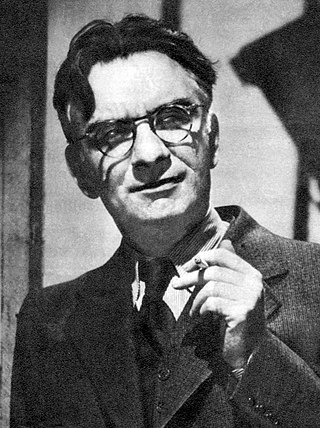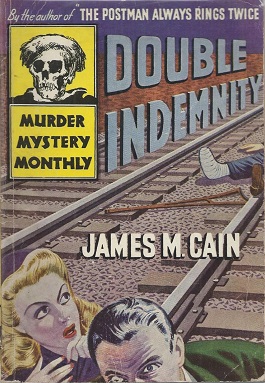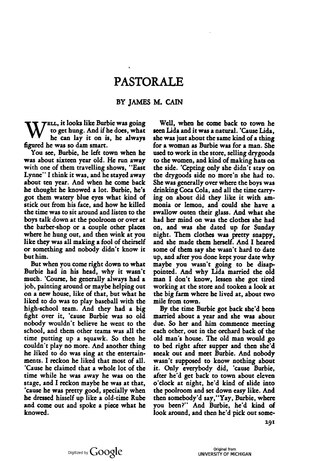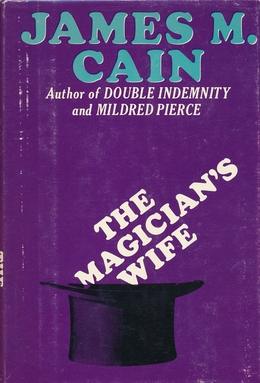Publication history
Jealous Woman originated at the behest of actor Edward G. Robinson, whose performance as the shrewd insurance investigator Keyes won him acclaim in film director Billy Wilder's Double Indemnity (1944). [8] Cain complied, but rather than reproduce Robinson's character Keyes as the wise, paternalistic and relentless insurance investigator, Cain reduces the role in Jealous Woman to that of an incompetent "dupe" and elevates his junior investigator Ed Horner (Walter Huff in Cain's novel Double Indemnity ) as the superior figure in the insurance company operations. [9] [10] [11]
Cain's willingness to sell what he considered mediocre material to Avon was in part pecuniary, in part that he considered Jealous Woman outside the realm of his opus and therefore exempt from serious literary critique. He acquiesced to Avon's change in title from Nevada Moon to Jealous Woman because the publisher assured Cain that this would enhance sales. He collected a $1000 advance for the novel. [12]
Avon released Jealous Woman in paperback in 1950. [13]
Critical assessment
We watch Cain the plot carpenter construct complications of action and character relationships; and, simultaneously, the characters themselves plot and execute intrigues—a visible, double fascination. But sometimes complications defeat Cain; for instance, the reader just cannot follow the intricacies of the insurance schemes and counter-schemes that proliferate in Jealous Woman.
David Madden,James M. Cain (1970) [14]
Jealous Woman is one of several novels written in the late 1940s and early 1950s that Cain would later dismiss from his oeuvre, in addition to Sinful Woman (1948), The Root of His Evil (1951), and Galatea . [15] [16]
Novelist and literary critic David Madden observes that "the little-known, low quality" Jealous Woman, along with its predecessor Sinful Woman (1948), were the closest Cain came to writing detective novels in the "Hammett-Chandler vein". [17] [18]
Cain's "happy ending" books of this period contrast sharply with his Depression-era novels. Literary critic Paul Skenazy writes:
Cain's return to the East began a new phase in his career, one notable for a further slackening of his artistic achievement and output ... Two small works appeared in paperback about the time of the move: Sinful Woman (1948) and Jealous Woman ..." [19] [20]

Mildred Pierce is a psychological drama by James M. Cain published by Alfred A. Knopf in 1941.

James Mallahan Cain was an American novelist, journalist and screenwriter. He is widely regarded as a progenitor of the hardboiled school of American crime fiction.

The Postman Always Rings Twice is a 1934 crime novel by American writer James M. Cain. The novel was successful and notorious upon publication. It is considered one of the most outstanding crime novels of the 20th century. The novel's mix of sexuality and violence was startling in its time and caused it to be banned in Boston.

Double Indemnity is a 1943 crime novel by American journalist-turned-novelist James M. Cain. It was first published in serial form in Liberty magazine in 1936 and later republished as one of "three long short tales" in the collection Three of a Kind.

“Pastorale” is a short story written by James M. Cain and published in March, 1928 by editor H. L. Mencken in The American Mercury. Written in the Ring Lardner style, the tale is told in a first-person narrative, delivered in the dialect of a resident of rural America. Both the point-of-view and the use of colloquial dialect for his protagonists, fully established in “Pastorale”, would be applied in many of Cain’s novels.
Career in C Major is an opera-themed novella by American writer James M. Cain, first published in 1938. First appearing as a serial in The American Magazine entitled "Two Can Sing", this comic romance is a departure from Cain's first novels, Postman Always Rings Twice (1934) and Double Indemnity (1936), both hardboiled crime stories that included premeditated murder. Redbook magazine, disappointed that Cain had exchanged his hard-boiled themes involving sex and murder for a "comedic adventure", declined to purchase the novella but Liberty obtained the piece and carried it as a serial in 1935.

Three of a Kind is a collection of three novellas by James M. Cain, published by Alfred A. Knopf in 1943. Each originally appeared as serials in magazines during the 1930s. The collection includes Double Indemnity, first published in 1936 as a serial for Liberty magazine; Career in C Major, originally entitled "Two Can Sing" when it appeared in The American Magazine in 1938; and The Embezzler, appearing in Liberty as "Money and the Woman", also in 1938.

Serenade is a novel by James M. Cain published in 1938 by Alfred A. Knopf. and one of four Cain novels to feature opera as a plot device. Loosely based on Bizet's Carmen, the story explores the sources of artistic development, in particular the role played by sexual orientation in the development of artistic talent.
The Embezzler is a 1938 short novel by James M. Cain. The work first appeared as a serial in Liberty magazine in 1940 under the title Money and the Woman. In 1943, Alfred A. Knopf published the work as The Embezzler in a collection of novellas by Cain entitled Three of a Kind.

Love's Lovely Counterfeit is a hard-boiled short novel by James M. Cain published by Alfred A. Knopf in 1942. The story is set in a Midwestern town where rival gangsters struggle to maintain control of their criminal enterprises. The work is one of only three of Cain's novels told from the third-person point-of-view.

Past All Dishonor is a historical novel by James M. Cain published by Alfred A. Knopf in 1946. The story is set during the American Civil War concerning a tragic love affair between a Confederate spy and a mining-camp prostitute in California and Nevada. The novel, praised by many critics, was one of Cain's most profitable literary successes.

The Butterfly is a hard-boiled novel by author James M. Cain published by Alfred A. Knopf in 1947. The story is set in rural West Virginia in the late 1930s and concerns a mystery surrounding an apparent case of father and daughter incest.
7-11 is a play by James M. Cain staged in August 1937 on Cape Cod produced by Richard Aldrich and directed by Alexander Dean.

Sinful Woman is a detective novel by James M. Cain that appeared originally as a paperback in 1947 by Avon publishers. Sinful Woman was the most commercially successful of three paperbacks Cain wrote for Avon in the late 1940s and early 1950s.

Galatea is a romance novel by James M. Cain published by Alfred A. Knopf in 1953. The story alludes to the mythological Galatea in which the sculptor Pygmalion falls in love with the ivory figure of a woman he has crafted. In Cain’s modernized version of the Greek legend, an overweight woman is transfigured through a program of weight reduction into a goddess-like beauty.

The Root of His Evil is a novel by James M. Cain published in paperback by Avon in 1951.

The Moth is a novel by James M. Cain published in 1948 by Alfred A. Knopf. The work is the last of Cain’s four novels to feature opera as a central element of the story; the others are Serenade (1937), Mildred Pierce (1941) and Career in C Major (1943) At over three-hundred pages, The Moth is Cain’s “most personal, most ambitious and longest book” in his oeuvre, attempting to convey a “broad, social landscape” of America in the 1930s.

Mignon is a historical novel by James M. Cain published by the Dial Press in 1962. Along with Past All Dishonor (1946), Mignon is one of Cain’s two historical novels set during the American Civil War.

The Magician's Wife is a novel by James M. Cain published in 1965 by Dial Press.

Cain X 3 is a collection of three previously published novels by James M. Cain, reissued in 1969 by Alfred A. Knopf, with an introduction by Tom Wolfe.
This page is based on this
Wikipedia article Text is available under the
CC BY-SA 4.0 license; additional terms may apply.
Images, videos and audio are available under their respective licenses.
















